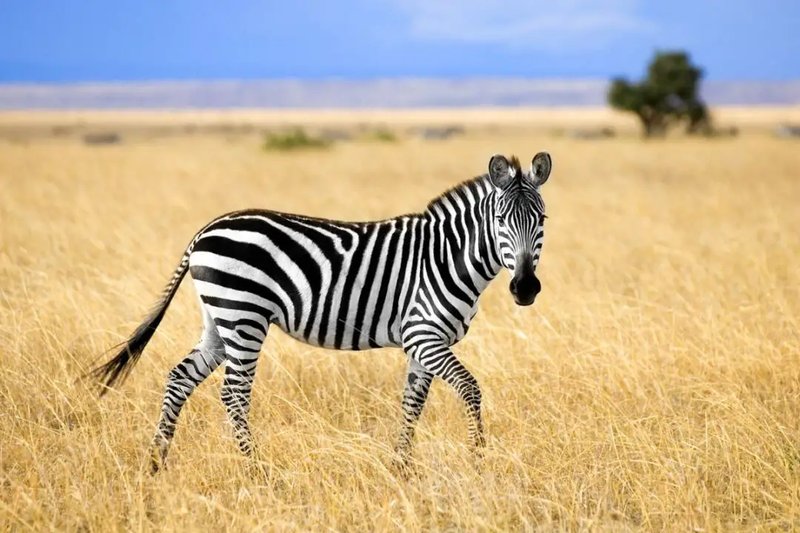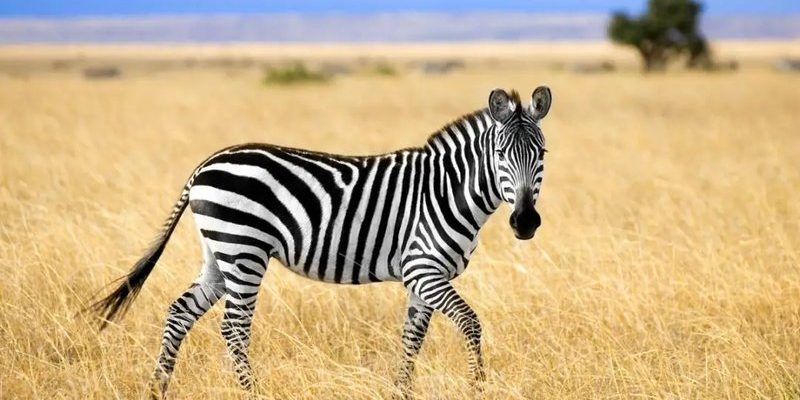
Let’s take a little safari through the animal kingdom, exploring ten animals that share traits with zebras and learning how to tell them apart. You might be surprised by some of the connections we discover!
1. Donkeys
Donkeys are often considered the underdogs of the equine world. While they don’t sport stripes like zebras, donkeys share a common ancestor and have similar body shapes. You might notice that donkeys have longer ears, a more rounded body, and their coats can range from gray to brown, though some might even have stripes or spots.
How to tell them apart: One of the easiest ways to distinguish a donkey from a zebra is by looking at the mane. Zebras have a shorter, erect mane that resembles a mohawk, while donkeys have a longer, flowing mane that lies flat against their neck. Additionally, donkeys have a braying sound, which is quite different from the zebra’s whinny.
2. Horses
Horses are probably the closest relatives to zebras. They share similar body structures and behaviors, and they’re both members of the Equidae family. Horses come in various breeds, colors, and sizes, and they’ve been domesticated for thousands of years.
How to tell them apart: Horses don’t have stripes, and their body shape can vary widely between breeds. Look for differences in size; zebras tend to be smaller and stockier than many horse breeds. Plus, horses often have a more varied temperament compared to the generally social and curious nature of zebras.
3. Okapis
Meet the okapi, often described as the “giraffe’s cousin.” While they bear a striking resemblance to zebras thanks to their striped legs, they are actually more closely related to giraffes. Okapis have a beautiful dark brown body with white stripes on their back legs, which helps them blend into the forests of the Congo.
How to tell them apart: Okapis have a long neck and a more elongated body compared to zebras. Their coloration is much darker overall, and their habitats diverge significantly—while zebras are found in savannas and grasslands, okapis thrive in dense forests.
4. Hippos
Now, here’s a surprise: hippos! Though they don’t look much like zebras at first glance, they share the same habitat in some areas of Africa. These massive creatures spend a lot of time in the water and on land, often grazing in the early morning or late evening.
How to tell them apart: Zebras are much lighter and more agile than hippos, who boast massive bodies. Additionally, zebras are herbivores that primarily eat grass, while hippos mostly consume grass and some aquatic plants. The two animals also have very different social behaviors; zebras form herds, while hippos prefer to stay in smaller groups.
5. Quaggas (Extinct)
The quagga is a fascinating case—it was a subspecies of the zebra that lived in South Africa until it went extinct in the late 1800s. Quaggas had stripes only on the front half of their bodies, with a brownish rear, making them visually similar but distinct compared to full-striped zebras.
How to tell them apart: The absence of stripes on the back end is the most notable difference between quaggas and zebras. While you won’t find quaggas roaming the earth today, their unique appearance makes for an interesting study into zebra evolution.
6. Wild Horses (Mustangs)
Mustangs are feral horses that roam freely in the western United States. Though they share many physical characteristics with zebras, such as body shape and grazing habits, mustangs can vary greatly in color—ranging from solid to spotted.
How to tell them apart: Mustangs lack stripes entirely. Their coats can be a mix of colors, including chestnut, black, and palomino, which makes them quite distinct from the striped appearance of zebras.
7. Giraffes
Though giraffes are known for their long necks, they share a habitat with zebras and are part of the same African ecosystem. Their unique coat patterns, made up of patches of brown and cream, can occasionally be confused with a zebra’s stripes, especially when viewed from a distance.
How to tell them apart: The most obvious difference is the neck length. Zebras have a stockier build, while giraffes are known for their towering height. Look for the distinct patchwork patterns on a giraffe, which differ greatly from the solid stripes found on zebras.
8. Antelopes
Antelopes come in various species and sizes, with many of them sharing habitats with zebras. Some, like the Grants gazelle, have a similar build and can even display stripes or spots on their coats.
How to tell them apart: Most antelopes are leaner, often boasting a more slender body compared to zebras. While some have stripes, they tend to be less pronounced and often interspersed with other colors—making them easier to distinguish when observing closely.
9. Cattle
Cattle, especially certain breeds, can have patterns on their coats that might remind you of zebras. Though they are domesticated animals and not closely related, some cows can display stripes or spots in their fur.
How to tell them apart: Cattle are generally much larger and bulkier than zebras. You’ll also notice their more rounded horns and broader heads. Plus, their coats can include a wide variety of colors, which contrasts with the strongly defined stripes of zebras.
10. Zebroids
Zebroids are hybrid animals that result from breeding a zebra with another equine species, like a horse or donkey. These hybrids inherit some of the zebra’s stripes, but the pattern can vary widely depending on the other parent.
How to tell them apart: Zebroids might have a mix of stripes and solid coloring, making them a unique sight. Their size and body structure can greatly differ, depending on whether they’re more like a horse or a donkey, but their heritage is clear when checking out their stripes.
In conclusion, the animal kingdom is fascinating and diverse, filled with creatures that share similarities with zebras in one way or another. Whether you’re observing them in the wild or learning about them in books, these ten animals remind us how interconnected life can be. Next time you spot a zebra, you might just think of its quirky relatives hanging out nearby!

